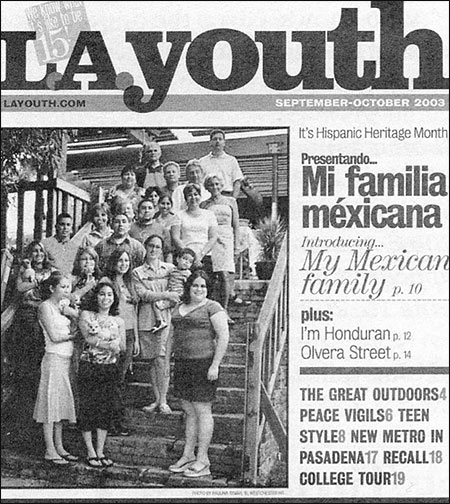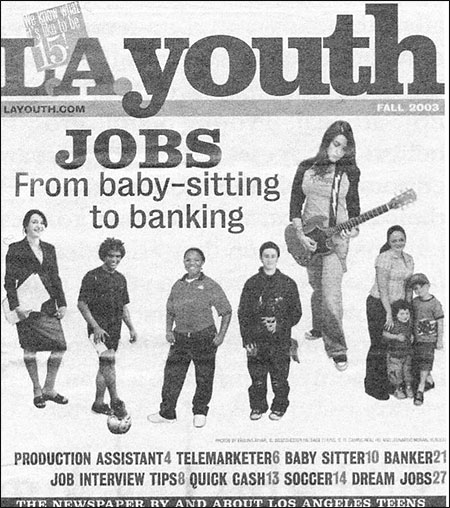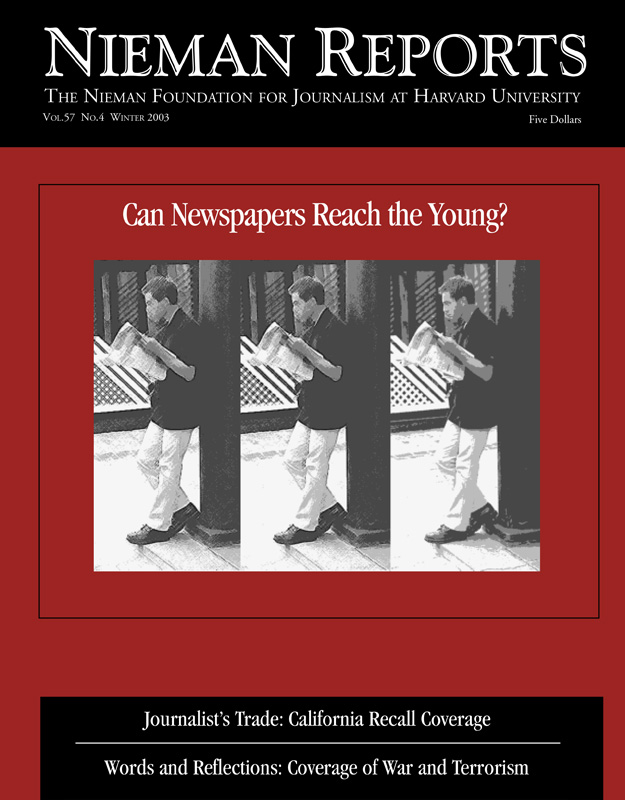There aren’t many cities where teenagers have their own newspaper to write and read, but in Los Angeles they do. It’s called L.A. Youth and, since 1988, it has given teens more than a voice. With it, they have had a megaphone.
I made my decision to publish a newspaper for teenagers in Los Angeles on the morning of January 13, 1988, the day when the United States Supreme Court struck down student press rights in Hazelwood v. Kuhlmeier. That decision gave school officials broad powers to censor student newspapers. That afternoon a dozen teenagers sat around my kitchen table talking about issues that affected their lives. Together we wondered how we would publish our own newspaper with no money. We didn’t even have a computer.
But we found some resources in the community—grants from The James Irvine Foundation and Bank of America Foundation, a few old typewriters from the Los Angeles Times, and a meeting place in a senior citizen center. These were enough to launch the first issue. Starting small with 2,500 copies published twice a year for two years, then growing year by year, we now publish six times each year, with 105,000 copies each issue. L.A. Youth has a readership of more than 300,000 in Los Angeles County. Our newspaper is read by students in public and private schools, by those who attend nearly 400 community-based youth programs, and can be found at most libraries. Every issue is posted on our Web site (www.layouth.com), and a Teacher’s Guide is mailed to 1,200 teachers who use L.A. Youth in their classrooms.

Teenagers create L.A. Youth, which reaches 300,000 young readers.
The Role of the Los Angeles Times
By 1994, L.A. Youth was publishing six times each year and, though the newspaper was well received, the costs of producing it were escalating. We had a full-time staff of four and 200 teens eager to join the staff. So I went looking for support from the newspaper industry. I approached then-Los Angeles Times publisher, David Laventhol, and asked if the Times would contribute newsprint and printing. I explained how our young reporters were helping their peers have a better understanding of the society they live in and the forces that act on them and showing them ways to gain more control over their lives. I described ways in which we do this, through news stories, self-help articles and in personal accounts, and talked about how our stories are written in an authentic teen voice and how this gives L.A. Youth its street credibility with readers.
Laventhol listened. When the meeting ended, he offered the Times’s support. He asked me how many copies we print. I picked a nice round number, 100,000, when we actually could only afford to print 35,000. He agreed to help us.
Printing our newspaper was just the beginning. Soon, former Los Angeles Times senior editor Noel Greenwood joined our nonprofit organization’s board of directors. Then came the Times’s donation of computers, cameras, scanners and other equipment to assist our struggling newspaper. Today, the Times’s newsroom operations editor, Dave Rickley, serves on our board, and he encourages colleagues from the Times to work with our newspaper. People who work in the prepress department, production and photo lab, the art director, and other folks involved with operations have volunteered. And as our teens report stories, they have received mentoring from Times’s editorial staff, too.
Putting Out the Paper
The teenagers who write for L.A. Youth gather after school and on Saturdays in our mid-Wilshire newsroom for editorial meetings. There they work with adult editors one-on-one to rewrite their stories; some articles take up to six months of reporting and rewriting before they are ready to be published.
L.A. Youth articles are often about traditional teen interests, such as summer jobs, getting into college, educational issues, and getting a date for the prom. But there is room for controversy in the paper, too. When our teenagers set out to explore such topics as teen pregnancy, substance abuse, AIDS, race relations, homelessness, gangs and other difficult topics, Los Angeles Times’s reporters, editors and lawyers share their expertise. An article we published in the summer of 1990 about alleged police abuse of local teens drew recognition from national media, including Time and “60 Minutes.” The Times Sunday opinion editor, Sue Horton, mentored teen reporter Josie Valderrama through the maze of internal affairs police documents while she worked on this year-long investigative project.
There are no requirements to join our staff. Teens bring friends, teachers refer students, and even parents call us looking for a summer workshop or a place for their son/daughter to improve his/her writing skills. On Newcomer’s Day, every other month, prospective writers, illustrators and photographers meet the adult staff. A give-and-take follows—about meeting deadlines; how we put together a newspaper; who our readers are; how many rewrites, etc. Some find it a challenge, and we never see them again. Others see it as an opportunity to voice their uncensored opinions and read their names in print. Alum keep in touch and return as mentors to the younger staff.
The teenagers’ personal stories are often touching. One of our teen reporters sleeps in a shelter and sometimes on the streets, yet he/she manages to work on a story. Students who attend private schools gather in our midcity office with teens whose lives are very different than theirs, and together they exchange story ideas with one another. Most of the time, these young writers meet the L.A. Youth deadlines while also coping with homework, family responsibilities, and personal relationships.
A few years ago, when I wanted to expand the youth voice to a wider audience, I spoke with several Los Angeles Times’s editors to ask if they’d consider reprinting our articles. Former Metro Editor Bill Boyarsky took the idea seriously and reprinted Gohar Galyan’s riveting article on life inside a year-round, overcrowded school. And one of our cover stories, written by a homeless youth sleeping behind a Hollywood Boulevard theater, made the front page of the Times’s Metro section.
Newspapers Learn From Us
The headline on June 17, 2000 screamed, “Tribune Co. acquires the Los Angeles Times.” I took a deep breath, answered the dozens of calls from friends inquiring about this merger and hoped nothing would change. In fact, since that day the relationship between our two newspapers has grown stronger. Publisher John Puerner and Editor John Carroll have kept the presses rolling for L.A. Youth and assured us that the Times has a commitment to high school journalism. However, during the past two years I have missed seeing some of our best stories find a broader readership in the Times. As the war took place in Iraq, for example, I kept hoping the new editors would see the relevance of the teen perspective on the war. Who knows better how teens feel about not finding a summer job in order to pay for college than those facing this situation? Or who can speak better to the impact of the ever-increasing classroom size on student learning?
Each year newspapers spend lots of money and time on focus groups and readership surveys as they try to figure out how to attract younger readers. By looking closely at publications like ours—at our contributors and our read-ers—and supporting in various ways independent teen-written newspapers like ours, those who edit and publish newspapers could see how we’re growing the next generation of critical thinkers, good citizens, and newspaper readers.
Donna C. Myrow is founder and executive director of L.A. Youth. Teen writers at the paper have gone on to have internships at National Public Radio, Sports Illustrated, Forbes, TeenPeople, the San Jose Mercury News, The Oakland Tribune and The Philadelphia Inquirer, and other print and broadcast news organizations.



